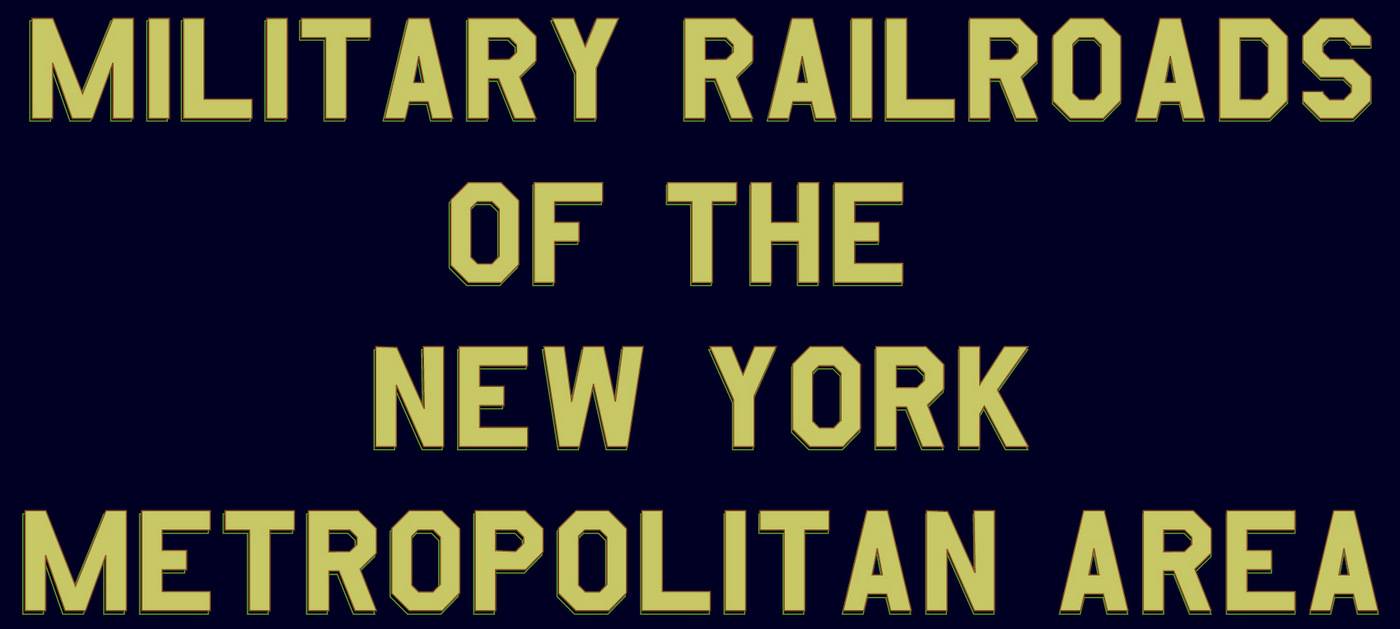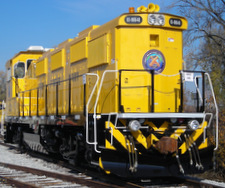WELCOME TO:
Military Railroads of the New
York Metropolitan Area

Fort
ARTILLERY COASTAL DEFENSE RAILROAD RAILWAY AMMUNITION DEPOT MAGAZINE
STATION MINES TORPEDO PROVING GROUND
ARMY TERMINAL NAVY YARD NAVAL SHIPYARD HAMILTON JAY GOVERNORS
ISLAND PLUM TERRY WOOD WADSWORTH
BEDLOES EARLE HANCOCK IONA SANDY HOOK SCHUYLER TILDEN TOTTEN FLEET
SUPPLY BASE BUREAU ORDNANCE QUARTERMASTER
BROOKLYN
QUEENS STATEN ISLAND RICHMOND BRONX MANHATTAN NEW YORK SUFFOLK NASSAU
ROCKLAND
MONMOUTH COUNTY NEW JERSEY
LONG ISLAND SOUND HARBOR BAY COLTS NECK LEONARDO ROCKAWAY STONY POINT
by
Philip M. Goldstein with
Paul F. Strubeck, Joseph S. Roborecky and
Thomas R. Flagg
among other
contributors.
|
Brooklyn Army
Terminal - Brooklyn, NY |
Fleet Supply
Base - Brooklyn, NY |
New York
Naval Shipyard "Brooklyn Navy Yard", NY |
Fort Tilden -
Rockaway, Queens, NY |
Governors Island -
Manhattan, NY |
 Iona Island NAVAL AMMUNITION Depot Stony Point, NY |
|
 Earle NAVAL AMMUNITION
Depot -
COLTS NECK, NJ |
||
| . | all images contained there are property of their respective copyright holder - no reuse or republication of images or text of this website without consent of author | |||
|
.. |
 Fort Terry - Plum Island, NY |
|
|
|
Military Railroads of New York Metropolitan Area Brooklyn Kings County Queens Manhattan Bronx Richmond Staten Island Suffolk Long Island Monmouth New Jersey NY NJ Quartermaster Corp Engineers Coastal Artillery Defense Department Fleet Supply Repatriation Mortuary Cars Transportation Corp Railway Army Navy Fort Base railnet rail network Liberty Ellis Yard Hamilton Hancock Tilden Wadsworth Schuyler Terry Plum Governors Jay Sandy Hook Proving Grounds Wood Bedloes Bedlows Terminal Transport Center
|
updated: |
||
|
|
||
|
update summary |
date |
location |
| disposition info for BNY 12 updated | 27 November 2022 | New York Naval Shipyard / Brooklyn Navy Yard |
.
.

.
.
|
MILITARY
RAILROADS |
|||||||||||||||||||||||||||||||||||||||||||||||||||||
|
. |
|||||||||||||||||||||||||||||||||||||||||||||||||||||
|
|||||||||||||||||||||||||||||||||||||||||||||||||||||
On this website, you will find a history of railroads & their respective locomotives that were located on military bases and installations that were located throughout the New York Metropolitan Area. These railways and locomotives served their locations in many ways: some facilities were coastal defense batteries, a few were supply depots, two were naval ammunition depots, while the Brooklyn Navy Yard was a shipyard.
In most cases there is not a great deal known about most of the operations as they were gone by the 1920's. Some rail operations were short and used to transport artillery shells and powder bags from storehouses ("magazines") to the gun batteries on those installations. These comprise the majority of the Fort locations on this website.
Others hauled matériel from the docks to the storehouses and vice versa as in the cases of the Fleet Supply Base, Brooklyn Army Terminal and Governors Island.
The Brooklyn Navy Yard's rail network was used for haulage of construction material as well as removal of debris during the Navy Yards' renovation & expansion, as well as the transportation of equipment and machinery from the manufacturing shops in the Navy Yard to the dry docks to be installed on the ship(s) under construction or repair, as well as for traveling cranes to assist in the construction or repair of warships.
And the newest additions to this website: Iona Island & Earle Naval Ammunition Depots were used to move ammunition, shells and other munitions to and from storage magazines and ships.
Unfortunately, very little if anything remains to be explored or viewed. The Governor's Island Railroad is mentioned on several websites but no longer exists in any form, as also with Forts Hamilton, Wadsworth, Schuyler and Terry. Remnants of the Fort Tilden and Fort Totten Railroads remain, but little documentation was to be found.
Naval Weapons Station Earle has the distinction of being the only active military installation with a railroad, but it is off limits to civilians and general exploration.
For the most part, we are left in a vacuum.
The Brooklyn Navy Yard (BNY) in contrast however, is literally covered with the remains of the railroad that once operated there, with a great deal of abandoned trackage and structures. This undoubtedly is the most researched and documented facility, as Tom Flagg composed an article on the Brooklyn Navy Yard, including the industrial infrastructure (cranes, derricks) and history of the facility in the July - December 2005 / Number 43 issue of Transfer Magazine, published by the Rail Marine Information Group. I highly recommend procuring a copy of this informative issue at www.trainweb.org/rmig.
It must also be kept in mind that the Brooklyn Navy Yard rail operation survived after the Government's control, when operation of the BNY trackage was contracted to the Brooklyn Eastern District Terminal. A portion of the BNY railway network was active as late as 1995, when the successor to the BEDT, the New York Cross Harbor RR transported subway cars to and from a transit car builder in residence at the Brooklyn Navy Yard.
As far as it is known, only the Brooklyn Navy Yard, Fort Wadsworth and Fort Tilden show the physical remains of their railroads. Here, you can actually follow existing trackage and view original structures which remain as well. Furthermore, as Fort Tilden is the only facility that is accessible to general public, I was able to take a great deal of photographs, and which can be viewed in the Fort Tilden chapter of this website. While you can still see the right of ways on Governors Island, all physical evidence of that railroad no longer exist.
As for motive power, there are many interesting facts (and questions) that abound regarding these locomotives used at these facilities. Some were of 36" gauge but most were standard gauge. Fort Tilden and Fort Hancock operated both narrow gauge and standard gauge. As for locomotives; we know of steam, diesel-mechanical and diesel-electric locomotives having been used and now compressed air, but in most cases photographs of the actual locomotive in use at that location had been seldom encountered.
There are two facilities covered here, that are not technically in the geographical area of "New York Metropolitan Area":
And it bears remembering, that there many more military installations within the New York Metropolitan Area which did not have a railway, and therefore are not covered by this website.
And, for those of you so interested in the in-depth histories of the locations on this website, I highly recommend a visit to the website of the Coastal Defense Study Group. Their website is nothing less than a treasure trove of documents and maps; concerning everything from placement of batteries, size and quantity of artillery guns, how many shells are stored at each battery; and other obscure logistical data that makes it all the so more interesting:
.
With that being said, please enjoy this little known and rarely publicized facet of New York Area railroading! And as with my other websites, all photograph and information contributions are most welcome! Thanks for taking the time to visit this website and don't forget to sign the Guestbook!
Philip
M.
Goldstein
Normangee, TX
(936) 396-6103
bedt14@aol.com
.
|
Please Note: |
For those of you who are interested.
.
I have been in communication with a member of the US Army at Fort Eustis (US Army Transportation Museum) who is researching the locomotives listed below under a FOIA request.
I have received a reply to my FOIA request of 28 April 2007; requesting of the US Army, Fort Eustis Transportation Command and Museum any information regarding steam locomotive operations on US Military Installations in New York Metropolitan area. Here is an excerpt from that email:
.
Ft Hamilton - Per Installation map current to 15/3/35 - No rail trackage
Ft Terry - Per Installation map current to 28/3/21 - No rail trackage
Ft Schuyler - Per Installation map current to 3/1/22 - No rail trackage
Ft Wadsworth - Per Installation map current to 15/3/38 - No rail trackage
Ft
Tilden - Per Installation map current to 15/3/35 - Internal rail net
only
with engine house near the Quartermaster Wharf.
I have checked the Baldwin builders list and was able to identify the following:
22726 08/03 2-4-2T Brooklyn Navy Yard No #
25743 0-4-0E U S Government - Governors Island No # - 20 hp Electric
After 1914 apparently engines were ordered in bulk lots and distributed as needed.
I forgot to write down the date for the electric but I will advise after I check the Alco & Porter lists to see what I can find.
PFC Van Derveer
Some locomotives listed in that email, were not yet "discovered" by me; so they were listed under their respective installations. Further updates will be uploaded as warranted.
.
.
| [1] | . | ALCo builders records | ..... | [21] | . | Trains Magazine, December 1973 |
| [2] | Baldwin builders records | [23] | Thomas R. Flagg; NY Harbor RR's | |||
| [3] | H. K. Porter builders records | [24] | Jay Bendersky; Brooklyn's Waterfront Railways | |||
| [4] | Pittsburgh builders records | [30] | data from photographer notes, D. Keller archives | |||
| [5] | Davenport builders records | [31] | Shore Line Trolley Museum website | |||
| [6] | Plymouth builders records (Twombley/Goldsmith) | [32] | Colin Churchers Industrial Locomotives in Canada | |||
| [7] | Birmingham Loco & Rail sales records | [33] | Robert Brendel compilation (w/ P.A. Copeland &D.E. Shelburne info) | |||
| [8] | Vulcan Iron Works builders records | [34] | Gene Gerstner research | |||
| [9] | Rhode Island builders records | [35] | Donald Nute website | |||
| [10] | Mack builders records | [36] | Illinois Railroad Museum website | |||
| [11] | BEDT records & sales prospectus | [37] | NorthEast Rails Website | |||
| [12] | Lima builders records | [44] | Bill Russell website | |||
| [13] | Whitcomb builders records | [45] | Sam Berliner, III website | |||
| [14] |
Schenectady builders records |
[55] | Paul Strubeck research | |||
| [15] | General Electric builders records |
.
.
.
.
For those of you who wish to visit my other railroad websites, please click here:
.
.
Art
Audley
for images and
information on the Governors Island Railroad
Donald
"Doc" Bayne
history on Iona Island
Sam Berliner, III
for allowing the
use images, and information of his Naval Weapons Station
Earle page
Connie Finley
for the
information, images and research that precipitated the creation of the
Fort Totten page
Tom Flagg
for
his assistance and information on the Brooklyn
Navy Yard,
and the use of his research
Cynthia Franco
DeGolyer
Library of Southern Methodist
University
David Mackay & New York
Central System Historical Society
for
furnishing track maps of the Iona Island vicinity
Chip
Marshall
for forwarding
the National Archives locomotive images
Paul
Miller
For forwarding
family history and image of Ft Schuyler locomotive
Donald Nute
use of his pictures of BNY #7 under
restoration
Joseph Roborecky
proofreading, assistance & support
Pierce
Rafferty
director: Henry
L. Ferguson Museum
contributing and
usage of 1898 Fort Terry construction photo w/
locomotive
Mary
Rasa
curator of the
Museum at Gateway NRA / Sandy Hook at Fort Hancock, NJ
Ken Sinari
mortar
images from 1894 Morgan Engineering salemen's
catalog
Allen Stanley
for furnishing his collection of builders
records
that was essential to
discovering the locomotives that were used at the Military Bases in the
NY
Area
Paul F. Strubeck
friend & fellow railroad historian
John
Taubeneck
locomotive and
crane / wrecker builders information
and Fort Wood /
Bedloes Island location
Alverita D. Mack,
June Pagan,
Hanh Lam,
Evert Bono, and
PFC Robert Van Derveer
of the United States Army Transportation
Museum; Fort Eustis, VA
for information per my request on steam locomotives on NY Area Military
Installations
the
Palisades Interstate Park Commission
for use of their
Iona Island images
the
National Archives & Records Adminstration
.
the
Coastal Defense Study Group website
for the
use of the Coastal Artillery Installation Maps of the 1920's Series
.
.
Please
click here
to learn about the
AUTHOR.
.
This
website is fondly and respectfully dedicated to the memory of SP4
Fernando DeRubeis,
a close family friend, whom I never met. He bravely gave his life for
his country.
|
||||||||